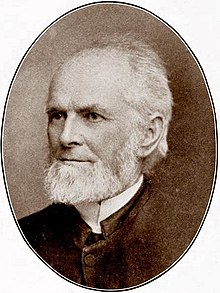
William Martin Beauchamp (March 25, 1830 – December 13, 1925) was an American ethnologist and Episcopal clergyman. He published several works on the archeology and ethnology of the Haudenosaunee (Iroquois) in New York.
Early life and education
Beauchamp was born in Coldenham, Orange County, New York. He received his education at Skaneateles Academy until 1845. He graduated from the DeLancey Divinity School, and received a degree of Doctor of Sacred Theology (S.T.D. Sacrae Theologiae Doctor) in 1886 from Hobart College. He married Sarah Carter of Ravenna, Ohio in November 1857 and resided in Syracuse, New York. His sister, Mary Elizabeth Beauchamp, was an educator and author.
Career
From 1865 to 1900, Beauchamp was rector of Grace Episcopal Church in Baldwinsville, N. Y. From 1884 to 1912 he was examining chaplain for the diocese of New York and from 1884-1910 he was archaeologist of New York State Museum. In 1894 Beauchamp was the first to seriously question the authenticity of the Pompey stone and prove that it was carved as a hoax.
In addition, he made valuable archæological contributions from his independent research, particularly concerning the Iroquois Indians. In 1889 the Bureau of American Ethnology commissioned him to survey the Iroquois territory in New York and Canada, and to prepare a map indicating the location of all the known Indian sites in that region. An enlargement of this map was published in Beauchamp's Aboriginal Occupation of New York (1900). His other works are:
- The Iroquois Trail (1892)
- Indian Names in New York (1893)
- Shells of Onondaga County (1896)
- History of the New York Iroquois, now Commonly Called the Six Nations (1905)
- Aboriginal Use of Wood in New York (1905)
- Aboriginal Place Names of New York (1907)
- Past and Present of Syracuse and Onondaga County (1908)
- Iroquois Folk Lore, Gathered From the Six Nations of New York (1922)
Member of organizations
- American Folklore Society
- Onondaga Historical Association (1909-1910)
- A.A.A.S.
References
- BEAUCHAMP, William Martin, in Who's Who in America (1926 edition); p. 247; via archive.org
- "William M. Beauchamp Papers, 1840-1944 (finding aid)". New York State Library Website. New York State Library. Retrieved 16 February 2016.
- The International Who's Who Pub. Co., 1911. p. 103.
- Bruce, Dwight Hall (1896). Onondaga's Centennial: Gleanings of a Century (Public domain ed.). Boston History Company. pp. 1092–.
- The International Who's Who Pub. Co., 1911. p. 103.
- Huguenin 1958, p. 40.
- Monfiletto, Jonathan (11 January 2017). "John Dodgson Barrow Portraits (Family & Friends)". The Citizen. Auburn, New York. p. 11. Retrieved 26 November 2020.
- Huguenin, Charles A. (Spring 1958). "The Pompey Stone". New York Folklore Quarterly. 14. New York Folklore Society: 34–43. ISSN 0028-7229.
This article incorporates text from a publication now in the public domain: Gilman, D. C.; Peck, H. T.; Colby, F. M., eds. (1905). New International Encyclopedia (1st ed.). New York: Dodd, Mead. {{cite encyclopedia}}: Missing or empty |title= (help)
External links
- Works by or about William Martin Beauchamp at the Internet Archive
- "William Martin Beauchamp", Minnesota State University-Mankato eMuseum
- Portrait by John Dodgson Barrow
- 1830 births
- 1925 deaths
- 19th-century American Episcopal priests
- 19th-century American non-fiction writers
- 20th-century American non-fiction writers
- 20th-century American Episcopal priests
- People from Montgomery, New York
- People from Baldwinsville, New York
- American archaeologists
- American ethnologists
- Historians from New York (state)
- 19th-century American male writers